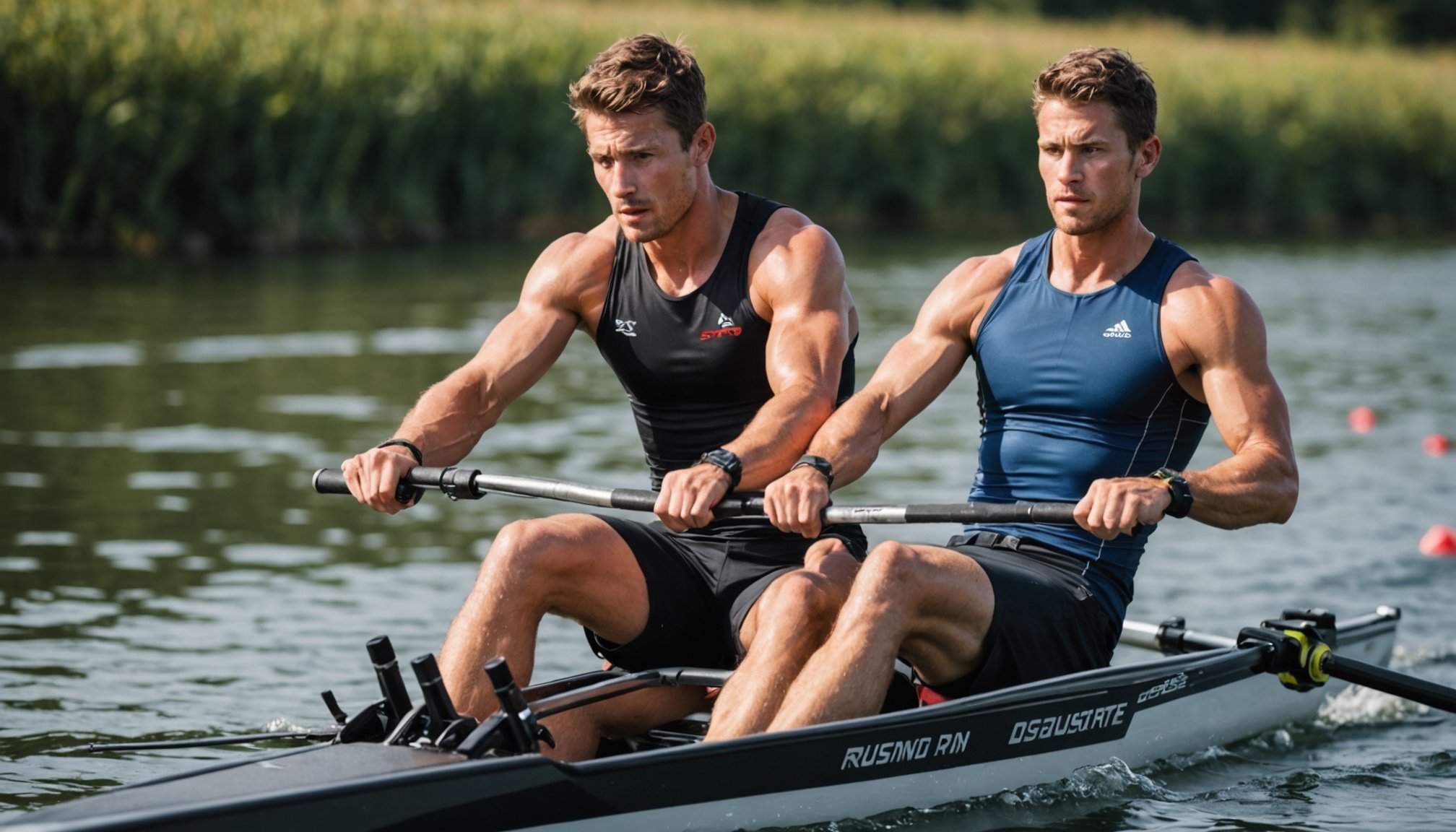Maximizing Rowing Performance: The Power of Heart Rate Monitoring for Enhanced Training
Understanding the Importance of Heart Rate Monitoring in Rowing
When it comes to optimizing your rowing performance, one of the most critical tools you can utilize is heart rate monitoring. This technique allows you to tailor your workouts to your body’s specific needs, ensuring you are pushing yourself to the right level of intensity without risking injury or burnout.
Heart rate monitoring is essentially a way to measure how hard your heart is working during exercise. For rowers, this data is invaluable because it helps in identifying the optimal intensity levels for different types of workouts. Here’s how it works:
Topic to read : Boosting Underwater Stamina: Essential Tips for Synchronized Swimmers
-
Heart Rate Zones: Heart rate zones are pre-defined ranges of heart rates that correspond to different levels of exercise intensity. For example, a low-intensity zone might be 50-60% of your maximum heart rate, while a high-intensity zone could be 80-90%. By monitoring your heart rate, you can ensure you are staying within the desired zone for your specific workout goals[2][3][4].
-
Customized Workouts: Using heart rate data, you can design workouts that are tailored to your fitness level and goals. For instance, if you are aiming to improve your endurance, you might focus on steady-state workouts in the moderate intensity zone. If you are looking to boost your power output, high-intensity interval training (HIIT) in the higher zones could be more effective.
In the same genre : Mastering Stroke Technique: A Competitive Swimmer”s Guide to Optimizing Performance Across Events
How Heart Rate Monitoring Enhances Rowing Training
Optimizing Intensity and Energy Expenditure
Heart rate monitoring helps you optimize the intensity of your rowing workouts, ensuring you are expending the right amount of energy. Here are some ways it enhances your training:
-
High Intensity Interval Training (HIIT): HIIT involves short bursts of high-intensity exercise followed by periods of rest or low-intensity exercise. By monitoring your heart rate, you can ensure you are reaching the high-intensity zones during these bursts, which is crucial for improving cardiovascular fitness and increasing power output.
-
Steady State Training: For endurance training, steady-state workouts involve maintaining a consistent heart rate over a longer period. This type of training helps in building cardiovascular endurance and improving the body’s ability to use oxygen efficiently.
-
Recovery Sessions: Heart rate monitoring also helps in managing recovery sessions. By keeping your heart rate in a low-intensity zone during recovery, you can ensure your body is getting the rest it needs without completely stopping activity.
Improving Technique and Efficiency
Apart from intensity, heart rate monitoring can also help in improving your rowing technique and overall efficiency:
-
Stroke Efficiency: By monitoring your heart rate in relation to your stroke rate and power output, you can identify areas where you might be wasting energy. For example, if your heart rate is high but your power output is low, it might indicate that your technique needs adjustment.
-
Body Alignment: Proper body alignment is crucial in rowing to avoid fatigue and injury. Heart rate data can help you understand how different body positions affect your heart rate and overall performance.
Tools and Devices for Heart Rate Monitoring
Wearable Devices
Wearable devices such as smartwatches and fitness trackers have become indispensable for athletes looking to monitor their heart rate during workouts. Here are some features to look for in a heart rate monitoring device:
-
Continuous Heart Rate Monitoring: Devices like the Garmin Forerunner 55 offer continuous heart rate monitoring, allowing you to track your heart rate in real-time throughout your workout[2][4].
-
GPS and Activity Tracking: Many devices come with integrated GPS and activity tracking features, which are particularly useful for rowers who also engage in other outdoor activities.
-
Water Resistance: Since rowing often involves water, it’s essential to choose a device that is water-resistant. The Garmin Forerunner 55, for example, is water-resistant up to 50 meters[2].
Rowing Machines with Heart Rate Monitors
Rowing machines can also be equipped with heart rate monitors, providing a comprehensive workout experience:
-
Integrated Heart Rate Monitors: Some rowing machines come with built-in heart rate monitors that sync with your device or display the data directly on the machine.
-
Data Analysis: These machines often provide detailed data analysis, including heart rate zones, power output, and stroke efficiency, helping you optimize your workouts.
Practical Tips for Using Heart Rate Monitoring in Rowing
Setting Up Your Heart Rate Zones
To get the most out of heart rate monitoring, you need to set up your heart rate zones correctly. Here’s a step-by-step guide:
- Determine Your Maximum Heart Rate: This can be estimated using the formula 220 – your age, or through a maximal exercise test.
- Calculate Your Heart Rate Zones: Divide your maximum heart rate into different zones (e.g., 50-60% for low intensity, 60-70% for moderate intensity, etc.).
Incorporating Heart Rate Monitoring into Your Workouts
Here are some practical tips for incorporating heart rate monitoring into your rowing workouts:
- Warm-Up and Cool-Down: Always start with a warm-up session to get your heart rate up gradually. Cool down afterwards to bring your heart rate back down.
- Interval Training: Use heart rate data to ensure you are hitting the right intensity during interval training. For example, aim for a high-intensity zone during sprints and a low-intensity zone during recovery periods.
- Steady State Workouts: For steady-state workouts, aim to maintain a consistent heart rate within your target zone.
Example Workout Plan Using Heart Rate Monitoring
Here’s an example of how you can structure a rowing workout plan using heart rate monitoring:
Warm-Up (10 minutes)
- Heart Rate Zone: 50-60% (low intensity)
- Activity: Light rowing to get the heart rate up and warm the muscles.
High-Intensity Interval Training (HIIT) (20 minutes)
- Heart Rate Zone: 80-90% (high intensity)
- Activity: Alternate between 2 minutes of high-intensity rowing and 2 minutes of low-intensity rowing.
Steady State Training (30 minutes)
- Heart Rate Zone: 60-70% (moderate intensity)
- Activity: Maintain a steady rowing pace to build endurance.
Cool-Down (10 minutes)
- Heart Rate Zone: 50-60% (low intensity)
- Activity: Light rowing to bring the heart rate back down.
Table: Comparing Heart Rate Monitoring Features in Popular Devices
| Device | Continuous Heart Rate Monitoring | GPS Integration | Water Resistance | Additional Features |
|---|---|---|---|---|
| Garmin Forerunner 55 | Yes | Yes | Up to 50 meters | PacePro, alertes de cadence, suivi du sommeil, suivi du stress[2][4] |
| Coros Pace 3 | Yes | Yes | Yes | Navigation virage par virage, profil d’élévation, suivi du cycle menstruel[3] |
| Polar Vantage V3 | Yes | Yes | Yes | ECG au poignet, mesure de la SpO2, guide d’itinéraire pas à pas[3] |
Quotes from Experts and Athletes
-
“Heart rate monitoring has been a game-changer for my rowing training. It allows me to tailor my workouts to my body’s specific needs, ensuring I’m always pushing myself to the right level of intensity.” – Sarah Johnson, Competitive Rower
-
“For rowers, heart rate monitoring is not just about tracking your heart rate; it’s about understanding how your body responds to different types of exercise. This data is crucial for optimizing performance and preventing injuries.” – Coach Mark Davis, Rowing Coach
Heart rate monitoring is a powerful tool for rowers looking to enhance their training and maximize their performance. By understanding and utilizing heart rate zones, you can design workouts that are tailored to your fitness level and goals. Whether you are using wearable devices or rowing machines with integrated heart rate monitors, the key is to use this data to optimize your intensity, technique, and overall efficiency.
Incorporating heart rate monitoring into your rowing routine can lead to significant improvements in your cardiovascular fitness, power output, and overall rowing performance. So, the next time you step onto your rowing machine or hit the water, make sure you are armed with the right tools and knowledge to take your training to the next level.











